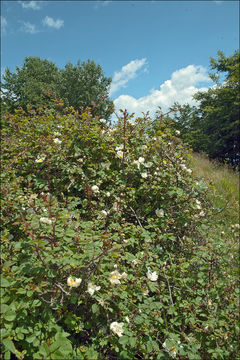Image of Field-rose

Description:
Slo.: njivski ipek - Habitat: former pasture, grassland partly overgrown with bushes and scattered Fagus Sylvatica, moderately inclined mountain slope near the top of a rounded mountain ridge; south aspect, sunny and dry place; calcareous, skeletal ground, exposed to direct rain; elevation 1.130 m (3.700 feet); average precipitations ~ 3.000 mm/year, average temperature 4-6 deg C, alpine phytogeographical region. Substratum: soil.Comment: Genus of roses (Rosa) is very beautiful. But it is taxonomically difficult. There are over hundred wild growing species known (hundreds of cultivars not taken into account, of cause), well over twenty are growing in Slovenia. More accurate numbers depend on to which botanical 'school one belongs'. Very frequent and numerous hybrids make determination of wild roses a 'small science by itself' like in genera Rubus, Alchemilla, Hieracium and some others. Only pros dedicate to a particular genus know, how to tell species, subspecies, varieties, forms and hybrids apart. For reliable determination of Rosa taxons one needs to study young shots and mature branches, leaves, flowers and hips in different stage of development. Such details like shape, size and distribution of spines, calyx leaves and their position after flowering is over (do they remain pointing radially, straight ahead or bend back, do they fall off early or late or not at all), hairiness of fruits, leaves, pistils, etc. must be taken into account. And, in addition, these entire traits are variable. In many cases one needs to visit a rose bush more than once in different seasons. Fortunately, Rosa arvensis seems an easy case for determination. Its typical long, glabrous pistils (almost as long as stamens), which are fused together into an inseparable bundle (see picture 6) and non-shining green leaves determine it well. In addition to Rosa arvensis such pistils are characteristic only for (also white blooming) Rosa sempervires. But the latter has distinctly shiny leaves and, doesn't grow in Alpine phytogeographical region of Slovenia but only in southwest part of it in warmer submediterranean phytogeographical region. Hence the determination of this find seems quite reliable.Ref.:(1) M.A. Fischer, W. Adler, K. Oswald, Exkursionsflora fr sterreich, Liechtenstein und Sdtirol, LO Landesmuseen, Linz, Austria (2005), p 521.(2) A. Martini et all., Mala Flora Slovenije (Flora of Slovenia - Key) (in Slovenian), Tehnina Zaloba Slovenije (2007), p 276. (3) E.J. Jger, Rothmaler 3, Exkursionsflora von Deutschland, 11. Aufl., Elsevier, Spectrum (2007), p 230. (4) D. Aeschimann, K. Lauber, D.M. Moser, J.P. Theurillat, Flora Alpina, Vol. 1., Haupt (2004), p 736.
Included On The Following Pages:
- Life (creatures)
- Cellular (cellular organisms)
- Eukaryota (eukaryotes)
- Archaeplastida (plants)
- Chloroplastida (green plants)
- Spermatophytes (seed plants)
- Angiosperms (Dicotyledons)
- Eudicots
- Superrosids
- Rosids
- Rosales ("Order: Roses, Figs, Nettles & relatives")
- Rosaceae (rose family)
- Rosa (rose)
- Rosa arvensis (Field-rose)
This image is not featured in any collections.
Source Information
- license
- cc-by-nc-sa-3.0
- copyright
- 2016 Dr. Amadej Trnkoczy
- photographer
- Dr. Amadej Trnkoczy
- original
- original media file
- visit source
- partner site
- CalPhotos
- ID


